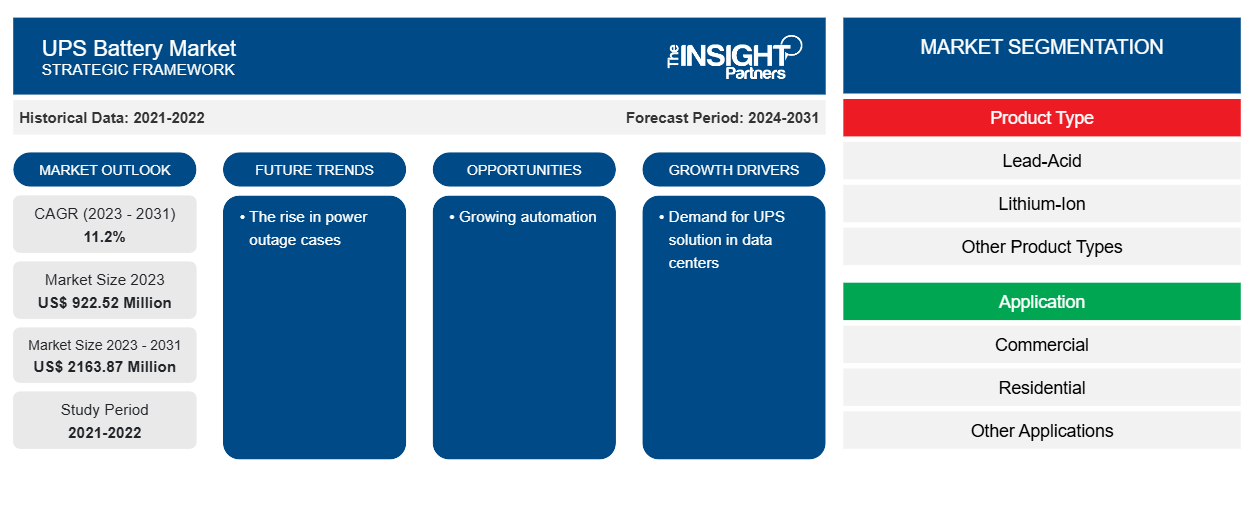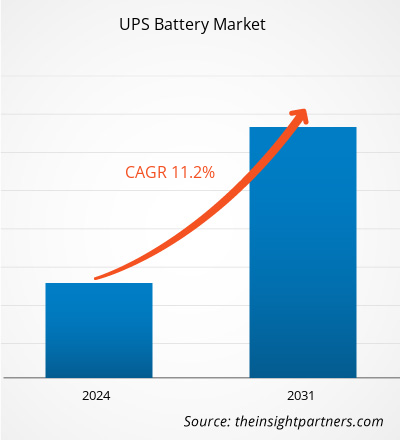The UPS battery market size is projected to reach US$ 2163.87 million by 2031 from US$ 922.52 million in 2023. The market is expected to register a CAGR of 11.2% during 2023–2031. The rise in power outage cases and the growing residential and commercial sector are likely to remain key trends in the market.
UPS Battery Market Analysis
The growing construction of large data centers in the corporate and industrial sectors generates the demand for UPS systems, which further drives the UPS battery market. The need for continuous power supply for mission-critical electronics, facilities, gadgets, critical infrastructure, and others drives the market growth further. The rise in power outage cases across the globe further demands UPS solutions, which further propels UPS battery market growth.
UPS Battery Market Overview
An uninterruptible power supply (UPS) battery or UPS power source is a type of power system that acts as electric power storage or backup during power failures or power outage issues. It is commonly used to protect hardware such as data centers, computers, telecommunication equipment or other electrical equipment where an unanticipated power disruption could cause injuries, fatalities, serious business disruption or data loss. The rise in data centers and the industrial sector is driving the market growth of UPS batteries.
Customize This Report To Suit Your Requirement
You will get customization on any report - free of charge - including parts of this report, or country-level analysis, Excel Data pack, as well as avail great offers and discounts for start-ups & universities
UPS Battery Market: Strategic Insights

-
Get Top Key Market Trends of this report.This FREE sample will include data analysis, ranging from market trends to estimates and forecasts.
UPS Battery Market Drivers and Opportunities
Demand for UPS solution in data centers
The UPS solution is a crucial system for mission-critical data center infrastructures. The presence of a UPS system delivers consistent and efficient power in the data centers. It supports the large data center when the primary power source goes down. The users need higher levels of uptime. This factor generates the need for increased power for the efficient working of the data center. UPS systems in the data center deliver the accurate amount of power within milliseconds of power loss. Thus, the growing data center market fosters the UPS battery market growth.
Wide end-user of UPS battery
The major end-users of the UPS battery market include commercial, residential, and industrial sectors. Food & beverage, pharmaceutical, power generation plants, and aerospace are some of the crucial industries surrounded by possibilities of power failures and very high ambient temperatures. Owing to the fact that UPS batteries are a key component of the UPS; It is accountable for good performance and long-lite span of UPS. In addition to their use, data centers, corporates, domestic appliances, and electrical gadgets are other applications of UPS. With the growing penetration of UPS, the scope of UPS batteries will be enhanced.
UPS Battery Market Report Segmentation Analysis
Key segments that contributed to the derivation of the UPS battery market analysis are the product type and application.
- Based on the product type, the UPS battery market is divided into lead-acid, lithium-ion, and other product types. The lithium-ion segment is expected to grow with the highest CAGR.
- By application, the market is segmented into commercial, residential, and other applications. The commercial segment held a significant share of the market in 2023.
UPS Battery Market Share Analysis by Geography
The geographic scope of the UPS battery market report is mainly divided into five regions: North America, Asia Pacific, Europe, Middle East & Africa, and South & Central America.
Asia Pacific region held the largest share of the market in 2023. The rise in the construction of data centers generates the demand for uninterrupted demand for power supply, which drives the UPS battery market growth in the region. The government authorities providing subsidies and the rise in investment of market players for the building hyperscale data centers further drive the market. The rise in the residential sector is driving market growth.
UPS Battery Market Regional Insights
The regional trends and factors influencing the UPS Battery Market throughout the forecast period have been thoroughly explained by the analysts at The Insight Partners. This section also discusses UPS Battery Market segments and geography across North America, Europe, Asia Pacific, Middle East and Africa, and South and Central America.
UPS Battery Market Report Scope
| Report Attribute | Details |
|---|---|
| Market size in 2023 | US$ 922.52 Million |
| Market Size by 2031 | US$ 2163.87 Million |
| Global CAGR (2023 - 2031) | 11.2% |
| Historical Data | 2021-2022 |
| Forecast period | 2024-2031 |
| Segments Covered |
By Product Type
|
| Regions and Countries Covered |
North America
|
| Market leaders and key company profiles |
|
UPS Battery Market Players Density: Understanding Its Impact on Business Dynamics
The UPS Battery Market is growing rapidly, driven by increasing end-user demand due to factors such as evolving consumer preferences, technological advancements, and greater awareness of the product's benefits. As demand rises, businesses are expanding their offerings, innovating to meet consumer needs, and capitalizing on emerging trends, which further fuels market growth.

- Get the UPS Battery Market top key players overview
UPS Battery Market News and Recent Developments
The UPS battery market is evaluated by gathering qualitative and quantitative data post primary and secondary research, which includes important corporate publications, association data, and databases. A few of the developments in the UPS battery market are listed below:
- C&D Technologies, a global leader in energy storage solutions for uninterruptible power supply (UPS) in the data center industry, introduced its premium Pure Lead Max (PLM) VRLA battery. The Pure Lead Max is the longest-lasting VRLA battery for UPS systems in C&D’s line-up and has an industry-leading eight-year warranty. (Source: C&D Technologies, Press Release, March 2023)
- Eaton announced the global launch of the 9PX lithium-ion uninterruptible power supply (UPS). Building on its leadership in delivering innovative lithium-ion battery capabilities in backup power solutions, Eaton’s new UPS provides longer battery life and a smaller footprint than valve-regulated lead-acid (VRLA) battery-powered UPS technology, making it ideal for distributed, “edge” environments and light industrial applications ranging from healthcare to education. (Source: Eaton, Press Release, July 2021)
UPS Battery Market Report Coverage and Deliverables
The “UPS Battery Market Size and Forecast (2021–2031)” report provides a detailed analysis of the market covering below areas:
- UPS battery market size and forecast at global, regional, and country levels for all the key market segments covered under the scope
- UPS battery market trends as well as market dynamics such as drivers, restraints, and key opportunities
- Detailed PEST/Porter’s Five Forces and SWOT analysis
- UPS battery market analysis covering key market trends, global and regional framework, major players, regulations, and recent market developments
- Industry landscape and competition analysis covering market concentration, heat map analysis, prominent players, and recent developments for the UPS battery market
- Detailed company profiles
Frequently Asked Questions
What would be the estimated value of the UPS battery market by 2031?
Which are the leading players operating in the UPS battery market?
What are the driving factors impacting the UPS battery market?
What is the future trend of the UPS battery market?
What is the expected CAGR of the UPS battery market?
- Historical Analysis (2 Years), Base Year, Forecast (7 Years) with CAGR
- PEST and SWOT Analysis
- Market Size Value / Volume - Global, Regional, Country
- Industry and Competitive Landscape
- Excel Dataset
Recent Reports
Related Reports
Testimonials
Reason to Buy
- Informed Decision-Making
- Understanding Market Dynamics
- Competitive Analysis
- Identifying Emerging Markets
- Customer Insights
- Market Forecasts
- Risk Mitigation
- Boosting Operational Efficiency
- Strategic Planning
- Investment Justification
- Tracking Industry Innovations
- Aligning with Regulatory Trends





















 Get Free Sample For
Get Free Sample For